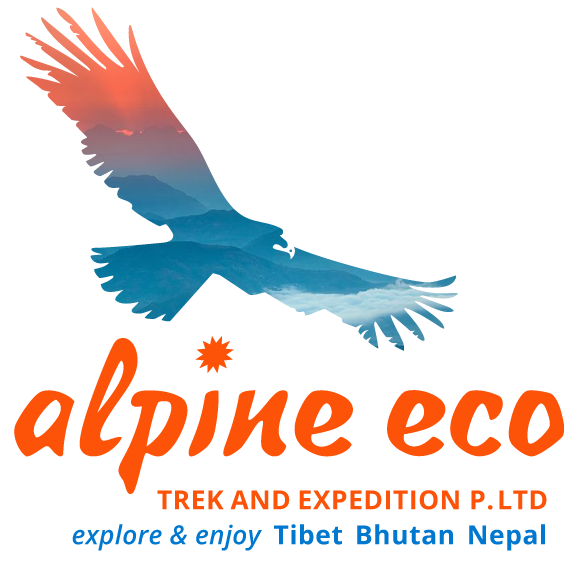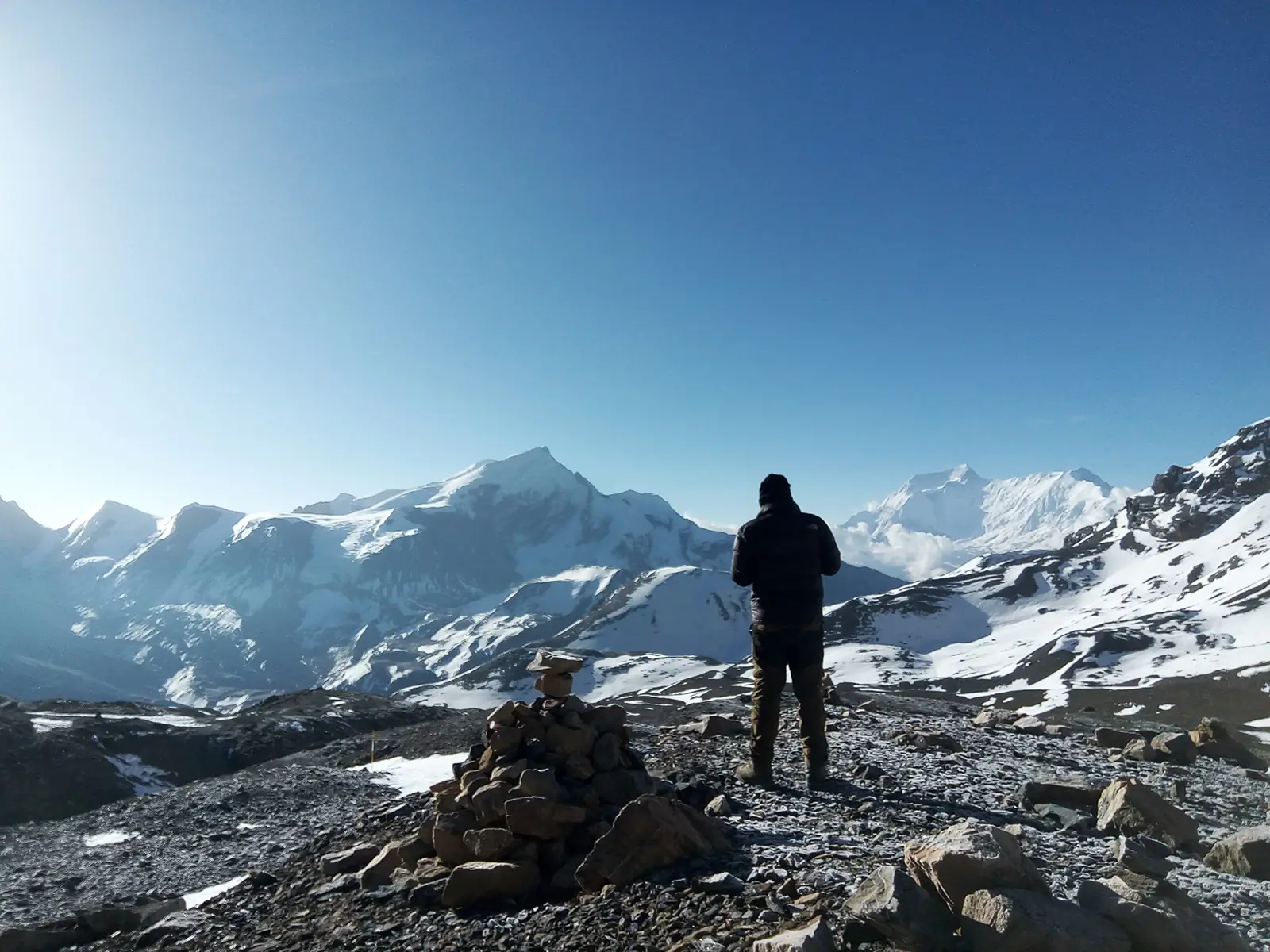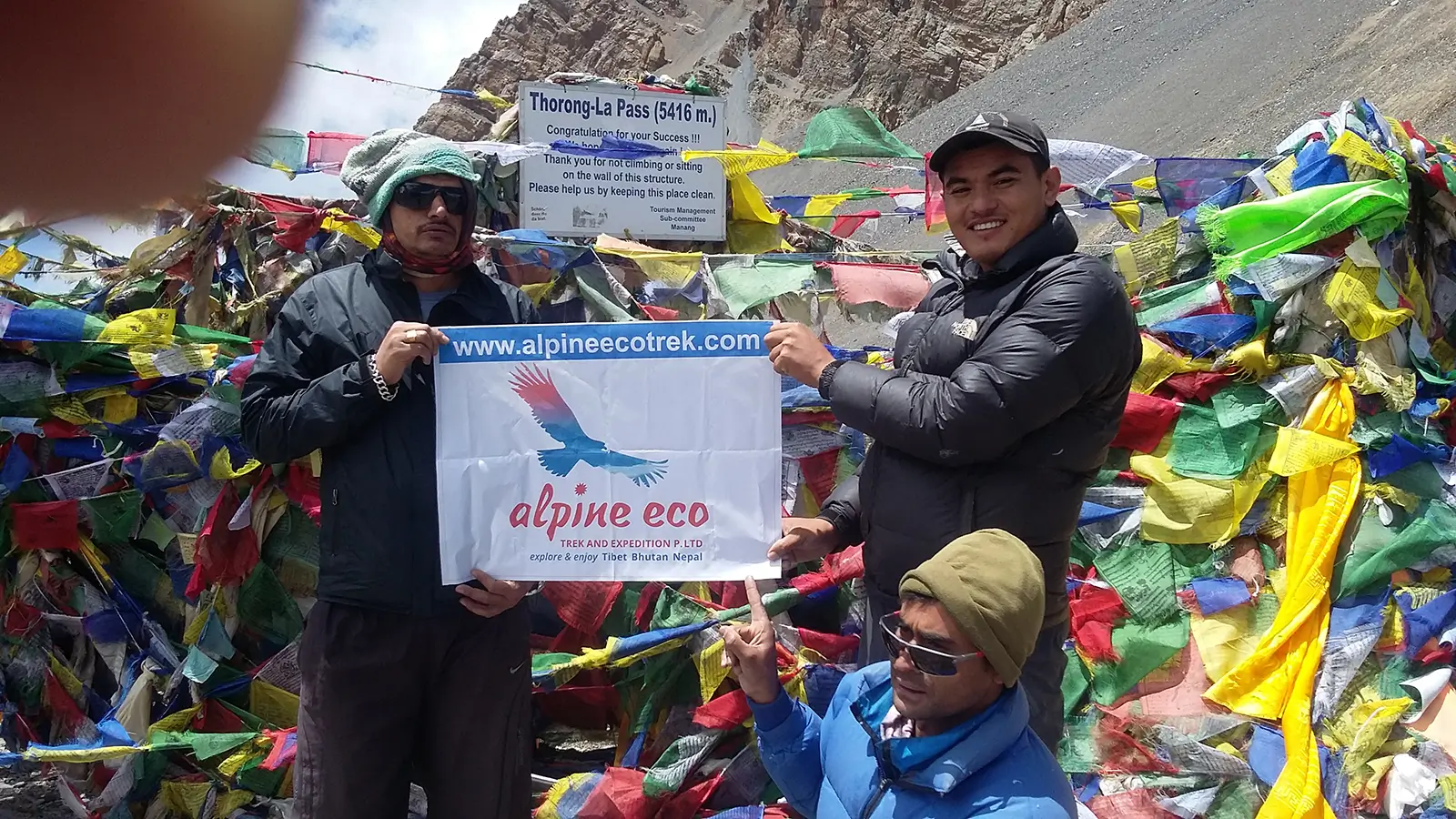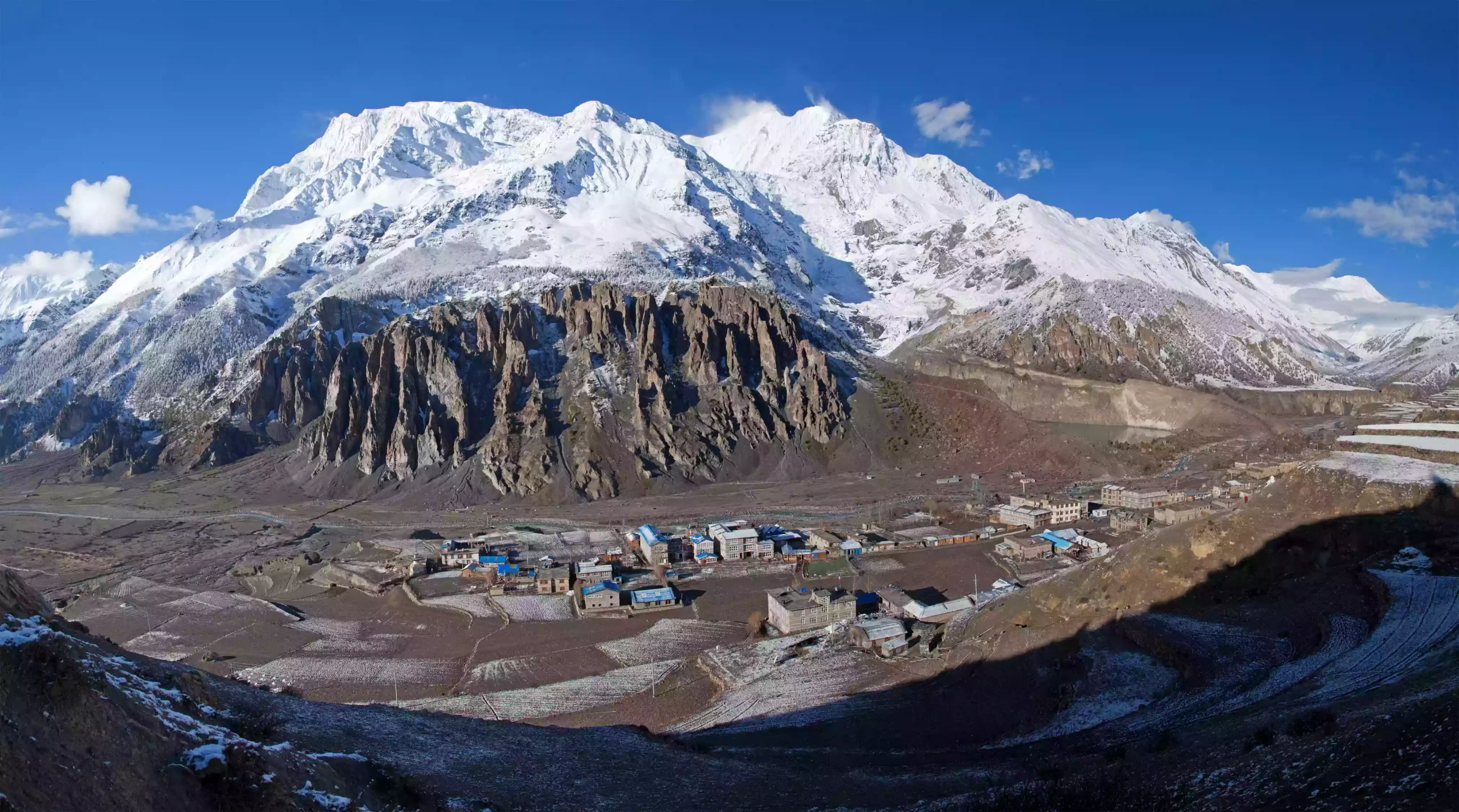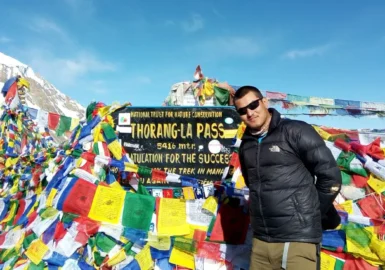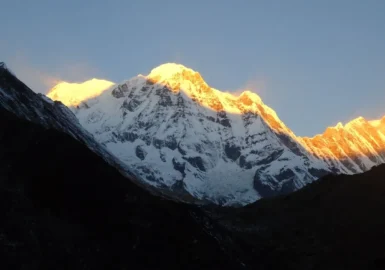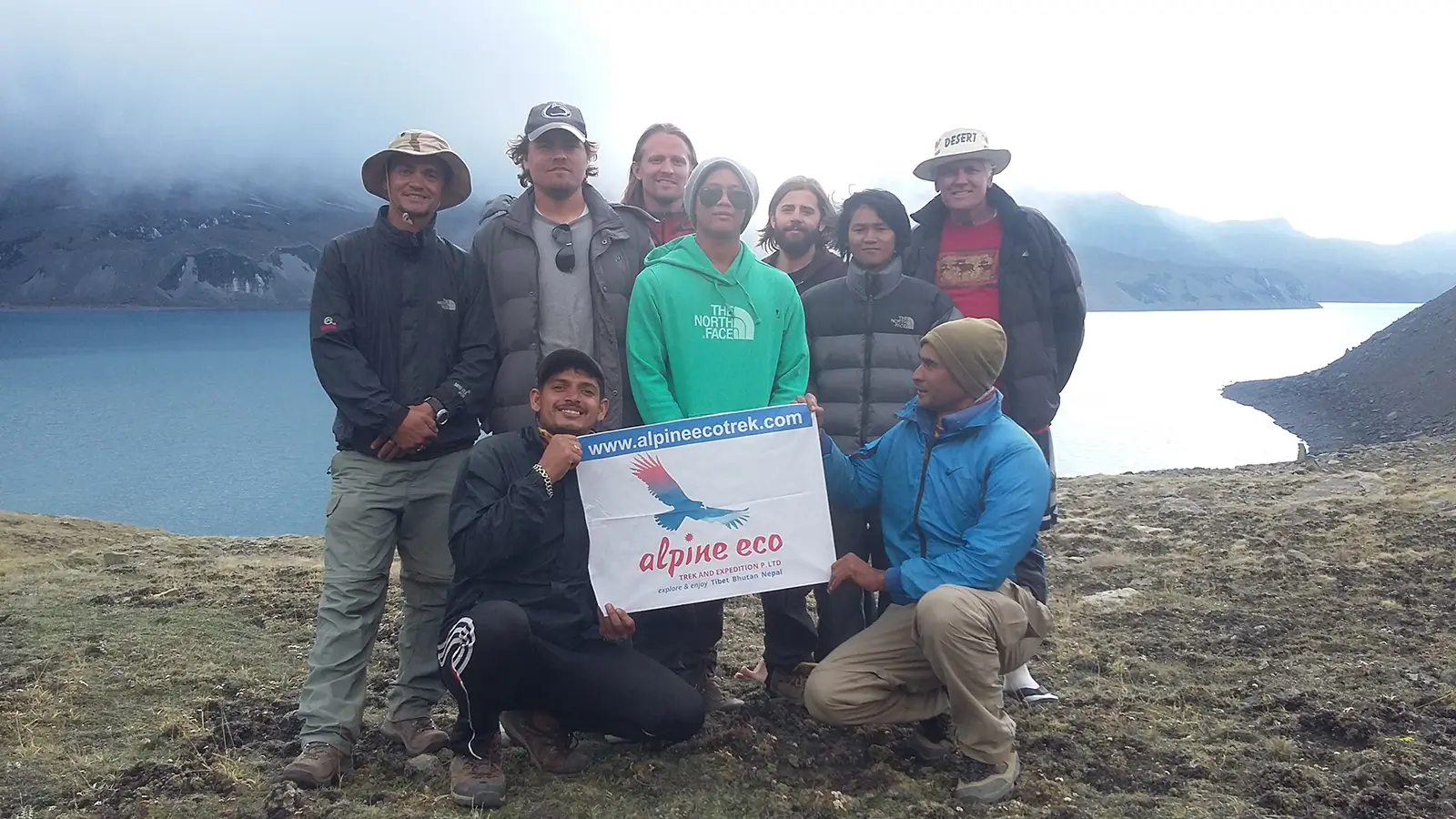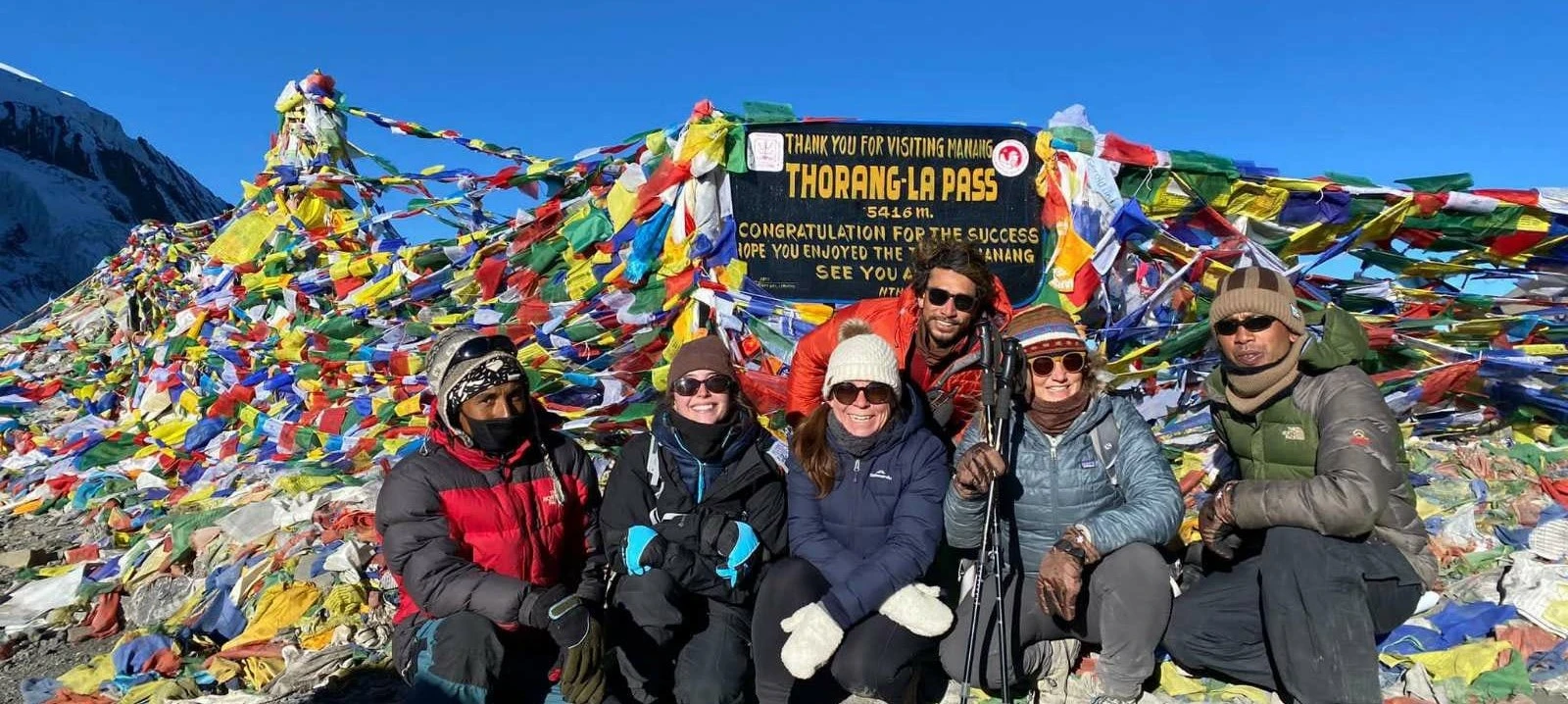
Embark on one of the challenging and thrilling trek in the Annapurna region via NATT Trails
Annapurna Circuit Trekking (NATT Trails)
-
Duration :18 Days
-
Group :Min 01- Max 20
Annapurna Circuit Trekking (NATT Trails) Trip Fact
-
Trip Style : Trekking, Hiking and Culture Exploration
-
Trip Difficulty : Strenuous Hiking
-
Trip Guide : Guided Trekking
-
 Destination : Annapurna, Nepal
Destination : Annapurna, Nepal -
 Max Altitude : 5,416 Meters - 17,769Ft
Max Altitude : 5,416 Meters - 17,769Ft -
Daily Walking Hours : Approx. 4-6 Hours Walking
-
 Accomodation: Hotel & Lodges
Accomodation: Hotel & Lodges -
 Food : Breakfast, Lunch and Dinner
Food : Breakfast, Lunch and Dinner -
Start-End : Kathmandu/Chamje
-
Transport : Local Bus or Private Jeeps
-
Best Season : Feb to June and Sept to Dec
Annapurna Circuit Trekking (Natural Annapurna Trekking Trails)
Annapurna circuit trekking is one of the most spectacular and fascinating treks within the Annapurna Himalayan range of central Nepal. This is a classic two to three-week popular trek in Annapurna that provides a magic blend of Himalayas exclusive cultures, scenery, and climate zones.
Natural Annapurna Trekking Trails starts from the lowland and rises to an altitude of 5416 m on the Thorong La pass, touching the edge of the Tibetan plateau. From the arid landscape of the Tibetan plateau to the world’s deepest Kali Gandaki gorge and the breathtaking view of the Annapurna massif and Tilicho Lake we are glad for choice in an extremely stunning region steeped in history, culture, religion, and tradition.
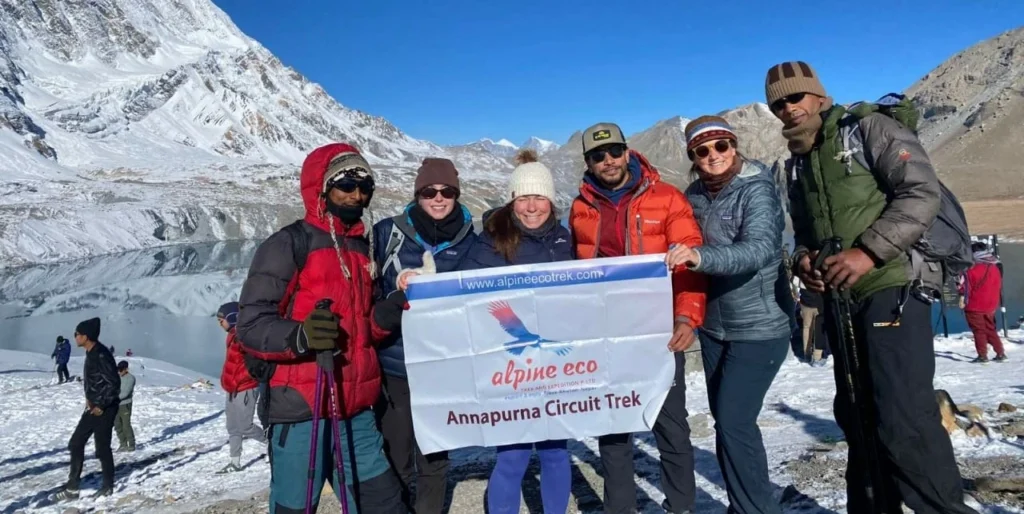
After you land in Nepal, you cannot miss exploring the ancient city of Kathmandu, where we will take you to explore the age-old monuments of Patan and Bhaktapur. The next day, we embark on Annapurna Natural trekking trails on a minibus and driving to the road ahead to Chamje and to the lush terrace fields of the lower Marsayangdi River valley.
We set foot on this trail and make our way alongside this ancient river as it cuts through the main Himalayan chain. Our companions during this trek will be bamboo and tropical vegetation. Soon the temperate climate makes its way to the arid desert and barren conditions of the Manang district, home to century-old Buddhist temples, medieval villages, and the native people, the Nyeshangs.
We set foot in the footsteps of the ancient salt traders over the highest pass in the world, the Thorong La pass. At 5,416m it is the highest trekking pass on earth and the spectacle from the top of Mt. Dhaulagiri (8,167m) is just stupendous. On the way down to the deepest gorge in the world, the Kali Gandaki gorge, we make a short visit to the holy temple of Muktinath, a sacred site for both Hindus and Buddhists. Witness how the locals indulge themselves while devoting themselves to God.
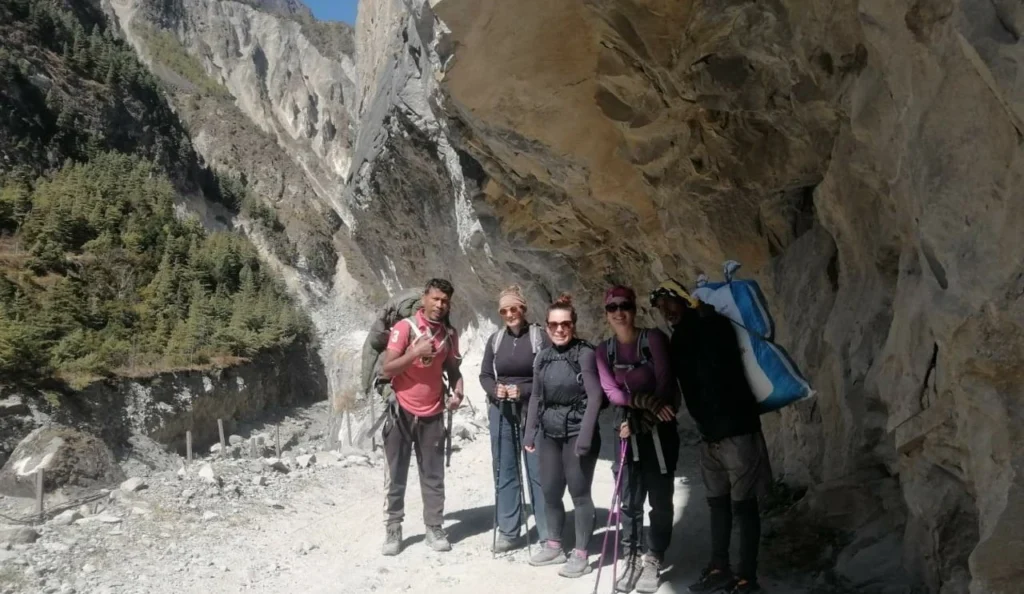
As we continue our descent, we arrive at Kagbeni and the junction of the Jhong Khola and Kali Gandaki Rivers (2,800). Eventually, we will end up in the deepest valley in the world. Surrounding us to the east is the splendid Annapurna (8,031m) which majestically sits astride the gorge, and on the west lies the towering peak of Dhaulagiri at 8,167m. Like sentinels of the rapidly flowing Kali Gandaki River, they guide us south towards the lush lowlands.
Continuing walking from Jomsom down to Tatopani and Ghorepani Poon Hill through natural trekking trails. As we descend through the trails, we will be surrounded by the cool winds of the pine and rhododendron forests which will lead us to the natural hot springs. Soak away the dust of the trail, revitalize, rejuvenate and relax. We also make a short ascent to the peak of the unmissable Poon Hill for the stunning and great views when the sun rises and the sun rays gently caress the mountain peaks. This a final reminder that you have just circumnavigated one of the most breathtaking mountain ranges on earth.
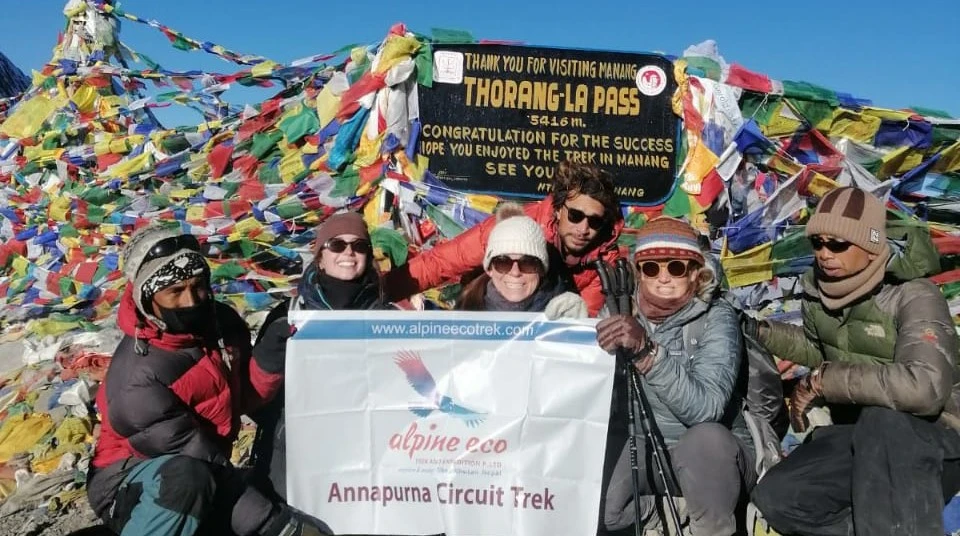
Trip Highlights
- Annapurna circuit 13 days is the most popular classic trek in the Annapurna region
- The trek will be organized from Kathmandu, anyone with good physical fitness can easily join the trek
- The trek leads to the Manang village, Tilicho Lake and Thorong La pass to Muktinath and Jomsom walking through terrace farming lands, traditional villages, cool and refreshing jungles crossing several bamboo bridges and waterfalls.
- This is the second most popular and famous trek in Nepal
- Explore a magic blend of beautiful landscapes and nature of the central Himalayan region of Nepal
- Enjoy the breathtaking views of the splendid Himalayan panorama of Annapurna massif, Mt. Manaslu, Mt. Fishtail, Mt. Nilgiri, Mt. Hinchuli and several other Midwestern Himalayan giants of Nepal
- Experience the diverse ethno-culture, lifestyles, topography on the shadow of incredible mountain vistas
-
Outline Itinerary
- + Show More
Drive on a 4WD from Kathmandu to Chamje (1,410m): 8-9 hours. Overnight at guest house with breakfast, lunch, dinner and tea/coffees.
-
 Accommodation: Guesthouse
Accommodation: Guesthouse
-
 Meals: Breakfast, Lunch and Dinner
Meals: Breakfast, Lunch and Dinner
-
 Place: Chamje
Place: Chamje
-
 Maximum Altitude:1,410m
Maximum Altitude:1,410m
Trek from Chamje to Dharapani (1,960m): 5 - 6 hours. Overnight at guest house with breakfast, lunch, dinner and tea/coffees.
-
 Accommodation: Guesthouse
Accommodation: Guesthouse
-
 Meals: Breakfast, Lunch and Dinner
Meals: Breakfast, Lunch and Dinner
-
 Place: Dharapani
Place: Dharapani
-
 Maximum Altitude:1,960m
Maximum Altitude:1,960m
Trek from Dharapani to Chame (2,710m): 5 - 6 hours. Overnight at guest house with breakfast, lunch, dinner and tea/coffees.
-
 Accommodation: Guesthouse
Accommodation: Guesthouse
-
 Meals: Breakfast, Lunch and Dinner
Meals: Breakfast, Lunch and Dinner
-
 Place: Chame
Place: Chame
-
 Maximum Altitude:2,710m
Maximum Altitude:2,710m
Trek from Chame to Pisang (3,300m): 5 - 6 hours. Overnight at guest house with breakfast, lunch, dinner and tea/coffees
-
 Accommodation: Guesthouse
Accommodation: Guesthouse
-
 Meals: Breakfast, Lunch and Dinner
Meals: Breakfast, Lunch and Dinner
-
 Place: Pisang
Place: Pisang
-
 Maximum Altitude:3,300m
Maximum Altitude:3,300m
Trek from Pisang to Manang (3,500m): 6 - 7 hours. Overnight at guest house with breakfast, lunch, dinner and tea/coffees.
-
 Accommodation: Guesthouse
Accommodation: Guesthouse
-
 Meals: Breakfast, Lunch and Dinner
Meals: Breakfast, Lunch and Dinner
-
 Place: Manang
Place: Manang
-
 Maximum Altitude:3,500m
Maximum Altitude:3,500m
Rest day in Manang Village. Day hike to Ice Lake and Gangapurna Lake. Overnight at the guest house with breakfast, lunch, dinner and tea/coffees
-
 Accommodation: Guesthouse
Accommodation: Guesthouse
-
 Meals: Breakfast, Lunch and Dinner
Meals: Breakfast, Lunch and Dinner
-
 Place: Manang
Place: Manang
-
 Maximum Altitude:3,500m
Maximum Altitude:3,500m
Trek from Manang to Khangsar (3745m): 2-3 hours. Overnight at guest house with breakfast, lunch, dinner and tea/coffees.
-
 Accommodation: Guesthouse
Accommodation: Guesthouse
-
 Meals: Breakfast, Lunch and Dinner
Meals: Breakfast, Lunch and Dinner
-
 Place: Khangsar
Place: Khangsar
-
 Maximum Altitude:3,745m
Maximum Altitude:3,745m
Trek from Khangsar to Tilicho Base Camp (4140m): 5-6 hours. Overnight at guest house with breakfast, lunch, dinner and tea/coffees.
-
 Accommodation: Guesthouse
Accommodation: Guesthouse
-
 Meals: Breakfast, Lunch and Dinner
Meals: Breakfast, Lunch and Dinner
-
 Place: Tilicho Base Camp
Place: Tilicho Base Camp
-
 Maximum Altitude:4,140m
Maximum Altitude:4,140m
Explore Tilicho Lake (4,949m) then trek back to base camp: 5-6 hours. Overnight at guest house with breakfast, lunch, dinner and tea/coffees.
-
 Accommodation: Guesthouse
Accommodation: Guesthouse
-
 Meals: Breakfast, Lunch and Dinner
Meals: Breakfast, Lunch and Dinner
-
 Place: Tilicho Lake
Place: Tilicho Lake
-
 Maximum Altitude:4,949m
Maximum Altitude:4,949m
Trek from Tilicho Base Camp to Yak Kharka (4040m): 4-5 hours. Overnight at guest house with breakfast, lunch, dinner and tea/coffees.
-
 Accommodation: Guesthouse
Accommodation: Guesthouse
-
 Meals: Breakfast, Lunch and Dinner
Meals: Breakfast, Lunch and Dinner
-
 Place: Yak Kharka
Place: Yak Kharka
-
 Maximum Altitude:4,040m
Maximum Altitude:4,040m
Trek from Yak kharka to Thorang Phedi: (4420m): 3-4 hours. Overnight at guest house with breakfast, lunch, dinner and tea/coffees.
-
 Accommodation: Guesthouse
Accommodation: Guesthouse
-
 Meals: Breakfast, Lunch and Dinner
Meals: Breakfast, Lunch and Dinner
-
 Place: Thorang Phedi
Place: Thorang Phedi
-
 Maximum Altitude:4,420m
Maximum Altitude:4,420m
Trek from Thorong Phedi to Muktinath (3,800m) via Thorong La pass (5416m): 7 - 8 hours. Overnight at guest house with breakfast, lunch, dinner and tea/coffees.
-
 Accommodation: Guesthouse
Accommodation: Guesthouse
-
 Meals: Breakfast, Lunch and Dinner
Meals: Breakfast, Lunch and Dinner
-
 Place: Thorong Pass - Muktinath
Place: Thorong Pass - Muktinath
-
 Maximum Altitude:5,416m / 3,800m
Maximum Altitude:5,416m / 3,800m
Trek from Muktinath to Lubra and to Jomsom and then to Marpha ( 2500m): 5 to 6 hours. Overnight at Guest house with breakfast, lunch, dinner and tea/coffees.
-
 Accommodation: Guesthouse
Accommodation: Guesthouse
-
 Meals: Breakfast, Lunch and Dinner
Meals: Breakfast, Lunch and Dinner
-
 Place: Marpha
Place: Marpha
-
 Maximum Altitude:2,500m
Maximum Altitude:2,500m
Trek from Marpha to Kokkethati ( 2300m): 6 to 6 hours. Overnight at Guest house with breakfast, lunch, dinner and tea/coffees.
-
 Accommodation: Guesthouse
Accommodation: Guesthouse
-
 Meals: Breakfast, Lunch and Dinner
Meals: Breakfast, Lunch and Dinner
-
 Place: Kokkethati
Place: Kokkethati
-
 Maximum Altitude:2,300m
Maximum Altitude:2,300m
Trek from Kokkethati to Dana ( 2100m): 5 to 6 hours. Overnight at Guest house with breakfast, lunch, dinner and tea/coffees.
-
 Accommodation: Guesthouse
Accommodation: Guesthouse
-
 Meals: Breakfast, Lunch and Dinner
Meals: Breakfast, Lunch and Dinner
-
 Place: Dana
Place: Dana
-
 Maximum Altitude:2,100m
Maximum Altitude:2,100m
Trek from Dana to Tatopani (1900m): (2,5 hours) + hot springs. Overnight at Guest house with breakfast, lunch, dinner and tea/coffees.
-
 Accommodation: Guesthouse
Accommodation: Guesthouse
-
 Meals: Breakfast, Lunch and Dinner
Meals: Breakfast, Lunch and Dinner
-
 Place: Tatopani
Place: Tatopani
-
 Maximum Altitude:1,900m
Maximum Altitude:1,900m
Trek from Tatopani to Ghorepani ( 2800m): 5 to 6 hours. Overnight at Guest house with breakfast, lunch, dinner and tea/coffees.
-
 Accommodation: Guesthouse
Accommodation: Guesthouse
-
 Meals: Breakfast, Lunch and Dinner
Meals: Breakfast, Lunch and Dinner
-
 Place: Ghorepani
Place: Ghorepani
-
 Maximum Altitude:2,800m
Maximum Altitude:2,800m
Hike Poon Hill early morning, after sunrise, back to the Guest house, pack and trek down to Tikhedunga, take a jeep from here to Pokhara. Service ends
-
 Accommodation: Hotel on your own
Accommodation: Hotel on your own
-
 Meals: Breakfast and Lunch
Meals: Breakfast and Lunch
-
 Place: Tikhedunga / Pokhara
Place: Tikhedunga / Pokhara
-
 Maximum Altitude:1,600m / 8,10m
Maximum Altitude:1,600m / 8,10m
Map of This Trek
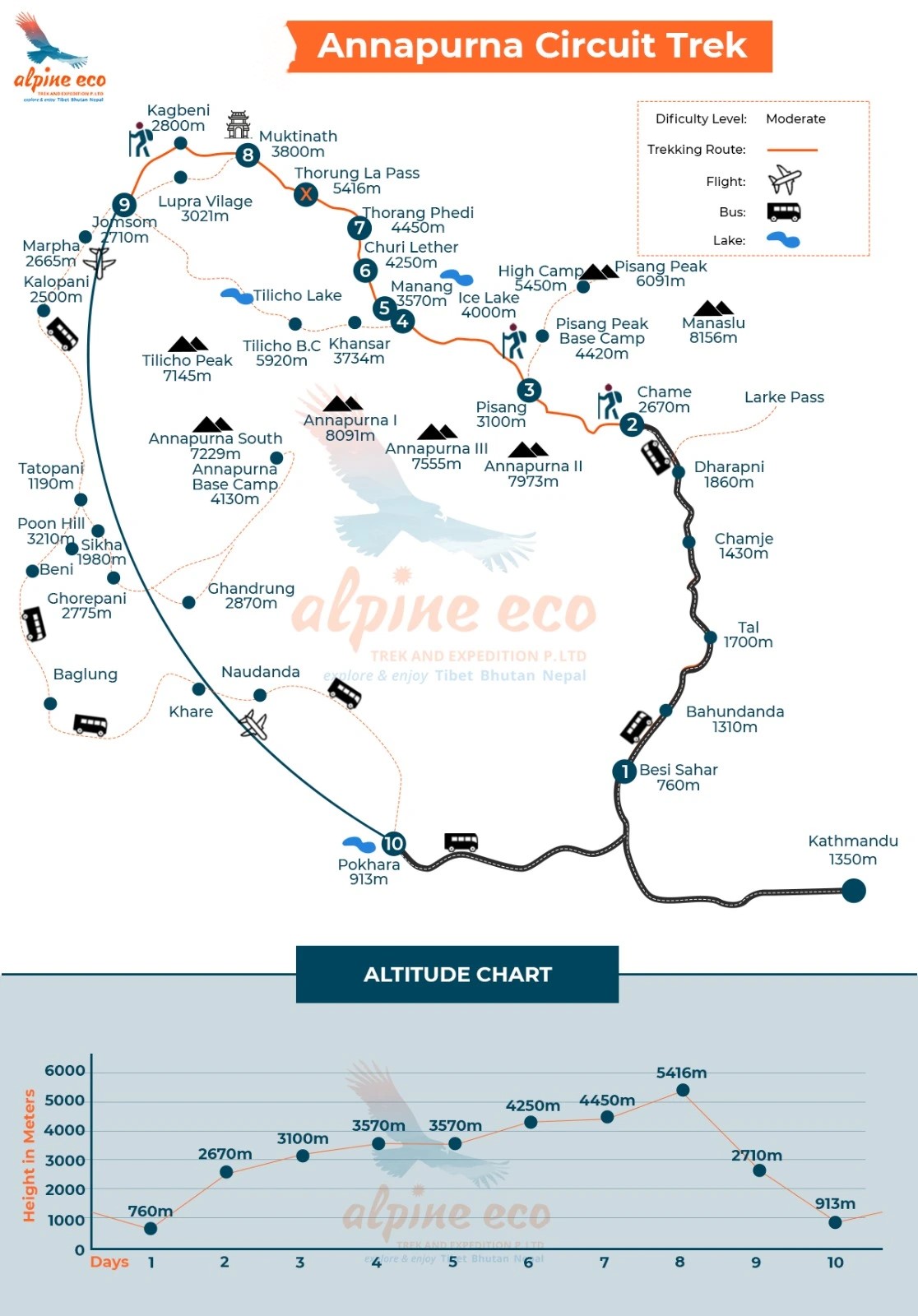
Annapurna Circuit Trekking (NATT Trails)
-
PRICES & DATES
| Start Date | Finish Date | Availability | Price | |
| 10th May, 2024 | 27th May, 2024 | Guaranteed | US$ 1190 | Book Now |
| 12th May, 2024 | 29th May, 2024 | Guaranteed | US$ 1190 | Book Now |
| 14th May, 2024 | 31st May, 2024 | Guaranteed | US$ 1190 | Book Now |
| 16th May, 2024 | 2nd June, 2024 | Guaranteed | US$ 1190 | Book Now |
| 18th May, 2024 | 4th June, 2024 | Guaranteed | US$ 1190 | Book Now |
| 20th May, 2024 | 6th June, 2024 | Guaranteed | US$ 1190 | Book Now |
| 22nd May, 2024 | 8th June, 2024 | Guaranteed | US$ 1190 | Book Now |
| 24th May, 2024 | 10th June, 2024 | Guaranteed | US$ 1190 | Book Now |
| 26th May, 2024 | 12th June, 2024 | Guaranteed | US$ 1190 | Book Now |
| 28th May, 2024 | 14th June, 2024 | Guaranteed | US$ 1190 | Book Now |
| 30th May, 2024 | 16th June, 2024 | Guaranteed | US$ 1190 | Book Now |
| 1st June, 2024 | 18th June, 2024 | Guaranteed | US$ 1190 | Book Now |
| 3rd June, 2024 | 20th June, 2024 | Guaranteed | US$ 1190 | Book Now |
| 5th June, 2024 | 22nd June, 2024 | Guaranteed | US$ 1190 | Book Now |
| 7th June, 2024 | 24th June, 2024 | Guaranteed | US$ 1190 | Book Now |
| 9th June, 2024 | 26th June, 2024 | Guaranteed | US$ 1190 | Book Now |
| 11th June, 2024 | 28th June, 2024 | Guaranteed | US$ 1190 | Book Now |
| 13th June, 2024 | 30th June, 2024 | Guaranteed | US$ 1190 | Book Now |
| 15th June, 2024 | 2nd July, 2024 | Guaranteed | US$ 1190 | Book Now |
| 17th June, 2024 | 4th July, 2024 | Guaranteed | US$ 1190 | Book Now |
| 19th June, 2024 | 6th July, 2024 | Guaranteed | US$ 1190 | Book Now |
| 21st June, 2024 | 8th July, 2024 | Guaranteed | US$ 1190 | Book Now |
| 23rd June, 2024 | 10th July, 2024 | Guaranteed | US$ 1190 | Book Now |
| 25th June, 2024 | 12th July, 2024 | Guaranteed | US$ 1190 | Book Now |
| 27th June, 2024 | 14th July, 2024 | Guaranteed | US$ 1190 | Book Now |
| 29th June, 2024 | 16th July, 2024 | Guaranteed | US$ 1190 | Book Now |
| 1st July, 2024 | 18th July, 2024 | Guaranteed | US$ 1190 | Book Now |
| 3rd July, 2024 | 20th July, 2024 | Guaranteed | US$ 1190 | Book Now |
| 5th July, 2024 | 22nd July, 2024 | Guaranteed | US$ 1190 | Book Now |
| 7th July, 2024 | 24th July, 2024 | Guaranteed | US$ 1190 | Book Now |
| 9th July, 2024 | 26th July, 2024 | Guaranteed | US$ 1190 | Book Now |
| 11th July, 2024 | 28th July, 2024 | Guaranteed | US$ 1190 | Book Now |
| 13th July, 2024 | 30th July, 2024 | Guaranteed | US$ 1190 | Book Now |
| 15th July, 2024 | 1st August, 2024 | Guaranteed | US$ 1190 | Book Now |
| 17th July, 2024 | 3rd August, 2024 | Guaranteed | US$ 1190 | Book Now |
| 19th July, 2024 | 5th August, 2024 | Guaranteed | US$ 1190 | Book Now |
| 21st July, 2024 | 7th August, 2024 | Guaranteed | US$ 1190 | Book Now |
| 23rd July, 2024 | 9th August, 2024 | Guaranteed | US$ 1190 | Book Now |
| 25th July, 2024 | 11th August, 2024 | Guaranteed | US$ 1190 | Book Now |
| 27th July, 2024 | 13th August, 2024 | Guaranteed | US$ 1190 | Book Now |
| 29th July, 2024 | 15th August, 2024 | Guaranteed | US$ 1190 | Book Now |
| 31st July, 2024 | 17th August, 2024 | Guaranteed | US$ 1190 | Book Now |
| 2nd August, 2024 | 19th August, 2024 | Guaranteed | US$ 1190 | Book Now |
| 4th August, 2024 | 21st August, 2024 | Guaranteed | US$ 1190 | Book Now |
| 6th August, 2024 | 23rd August, 2024 | Guaranteed | US$ 1190 | Book Now |
| 8th August, 2024 | 25th August, 2024 | Guaranteed | US$ 1190 | Book Now |
| 10th August, 2024 | 27th August, 2024 | Guaranteed | US$ 1190 | Book Now |
| 12th August, 2024 | 29th August, 2024 | Guaranteed | US$ 1190 | Book Now |
| 14th August, 2024 | 31st August, 2024 | Guaranteed | US$ 1190 | Book Now |
| 16th August, 2024 | 2nd September, 2024 | Guaranteed | US$ 1190 | Book Now |
| 18th August, 2024 | 4th September, 2024 | Guaranteed | US$ 1190 | Book Now |
| 20th August, 2024 | 6th September, 2024 | Guaranteed | US$ 1190 | Book Now |
| 22nd August, 2024 | 8th September, 2024 | Guaranteed | US$ 1190 | Book Now |
| 24th August, 2024 | 10th September, 2024 | Guaranteed | US$ 1190 | Book Now |
| 26th August, 2024 | 12th September, 2024 | Guaranteed | US$ 1190 | Book Now |
| 28th August, 2024 | 14th September, 2024 | Guaranteed | US$ 1190 | Book Now |
| 30th August, 2024 | 16th September, 2024 | Guaranteed | US$ 1190 | Book Now |
| 1st September, 2024 | 18th September, 2024 | Guaranteed | US$ 1190 | Book Now |
| 3rd September, 2024 | 20th September, 2024 | Guaranteed | US$ 1190 | Book Now |
| 5th September, 2024 | 22nd September, 2024 | Guaranteed | US$ 1190 | Book Now |
| 7th September, 2024 | 24th September, 2024 | Guaranteed | US$ 1190 | Book Now |
| 9th September, 2024 | 26th September, 2024 | Guaranteed | US$ 1190 | Book Now |
| 11th September, 2024 | 28th September, 2024 | Guaranteed | US$ 1190 | Book Now |
| 13th September, 2024 | 30th September, 2024 | Guaranteed | US$ 1190 | Book Now |
| 15th September, 2024 | 2nd October, 2024 | Guaranteed | US$ 1190 | Book Now |
| 17th September, 2024 | 4th October, 2024 | Guaranteed | US$ 1190 | Book Now |
| 19th September, 2024 | 6th October, 2024 | Guaranteed | US$ 1190 | Book Now |
| 21st September, 2024 | 8th October, 2024 | Guaranteed | US$ 1190 | Book Now |
| 23rd September, 2024 | 10th October, 2024 | Guaranteed | US$ 1190 | Book Now |
| 25th September, 2024 | 12th October, 2024 | Guaranteed | US$ 1190 | Book Now |
| 27th September, 2024 | 14th October, 2024 | Guaranteed | US$ 1190 | Book Now |
| 29th September, 2024 | 16th October, 2024 | Guaranteed | US$ 1190 | Book Now |
| 1st October, 2024 | 18th October, 2024 | Guaranteed | US$ 1190 | Book Now |
| 3rd October, 2024 | 20th October, 2024 | Guaranteed | US$ 1190 | Book Now |
| 5th October, 2024 | 22nd October, 2024 | Guaranteed | US$ 1190 | Book Now |
| 7th October, 2024 | 24th October, 2024 | Guaranteed | US$ 1190 | Book Now |
| 9th October, 2024 | 26th October, 2024 | Guaranteed | US$ 1190 | Book Now |
| 11th October, 2024 | 28th October, 2024 | Guaranteed | US$ 1190 | Book Now |
| 13th October, 2024 | 30th October, 2024 | Guaranteed | US$ 1190 | Book Now |
| 15th October, 2024 | 1st November, 2024 | Guaranteed | US$ 1190 | Book Now |
| 17th October, 2024 | 3rd November, 2024 | Guaranteed | US$ 1190 | Book Now |
| 19th October, 2024 | 5th November, 2024 | Guaranteed | US$ 1190 | Book Now |
| 21st October, 2024 | 7th November, 2024 | Guaranteed | US$ 1190 | Book Now |
| 23rd October, 2024 | 9th November, 2024 | Guaranteed | US$ 1190 | Book Now |
| 25th October, 2024 | 11th November, 2024 | Guaranteed | US$ 1190 | Book Now |
| 27th October, 2024 | 13th November, 2024 | Guaranteed | US$ 1190 | Book Now |
| 29th October, 2024 | 15th November, 2024 | Guaranteed | US$ 1190 | Book Now |
| 31st October, 2024 | 17th November, 2024 | Guaranteed | US$ 1190 | Book Now |
| 2nd November, 2024 | 19th November, 2024 | Guaranteed | US$ 1190 | Book Now |
| 4th November, 2024 | 21st November, 2024 | Guaranteed | US$ 1190 | Book Now |
| 6th November, 2024 | 23rd November, 2024 | Guaranteed | US$ 1190 | Book Now |
| 8th November, 2024 | 25th November, 2024 | Guaranteed | US$ 1190 | Book Now |
| 10th November, 2024 | 27th November, 2024 | Guaranteed | US$ 1190 | Book Now |
| 12th November, 2024 | 29th November, 2024 | Guaranteed | US$ 1190 | Book Now |
| 14th November, 2024 | 1st December, 2024 | Guaranteed | US$ 1190 | Book Now |
| 16th November, 2024 | 3rd December, 2024 | Guaranteed | US$ 1190 | Book Now |
| 18th November, 2024 | 5th December, 2024 | Guaranteed | US$ 1190 | Book Now |
| 20th November, 2024 | 7th December, 2024 | Guaranteed | US$ 1190 | Book Now |
| 22nd November, 2024 | 9th December, 2024 | Guaranteed | US$ 1190 | Book Now |
| 24th November, 2024 | 11th December, 2024 | Guaranteed | US$ 1190 | Book Now |
| 26th November, 2024 | 13th December, 2024 | Guaranteed | US$ 1190 | Book Now |
| 28th November, 2024 | 15th December, 2024 | Guaranteed | US$ 1190 | Book Now |
| 30th November, 2024 | 17th December, 2024 | Guaranteed | US$ 1190 | Book Now |
| 2nd December, 2024 | 19th December, 2024 | Guaranteed | US$ 1190 | Book Now |
| 4th December, 2024 | 21st December, 2024 | Guaranteed | US$ 1190 | Book Now |
| 6th December, 2024 | 23rd December, 2024 | Guaranteed | US$ 1190 | Book Now |
| 8th December, 2024 | 25th December, 2024 | Guaranteed | US$ 1190 | Book Now |
| 10th December, 2024 | 27th December, 2024 | Guaranteed | US$ 1190 | Book Now |
| 12th December, 2024 | 29th December, 2024 | Guaranteed | US$ 1190 | Book Now |
| 14th December, 2024 | 31st December, 2024 | Guaranteed | US$ 1190 | Book Now |
| 16th December, 2024 | 2nd January, 2025 | Guaranteed | US$ 1190 | Book Now |
| 18th December, 2024 | 4th January, 2025 | Guaranteed | US$ 1190 | Book Now |
| 20th December, 2024 | 6th January, 2025 | Guaranteed | US$ 1190 | Book Now |
| 22nd December, 2024 | 8th January, 2025 | Guaranteed | US$ 1190 | Book Now |
| 24th December, 2024 | 10th January, 2025 | Guaranteed | US$ 1190 | Book Now |
| 26th December, 2024 | 12th January, 2025 | Guaranteed | US$ 1190 | Book Now |
| 28th December, 2024 | 14th January, 2025 | Guaranteed | US$ 1190 | Book Now |
| 30th December, 2024 | 16th January, 2025 | Guaranteed | US$ 1190 | Book Now |
| 1st January, 2025 | 18th January, 2025 | Guaranteed | US$ 1190 | Book Now |
| 3rd January, 2025 | 20th January, 2025 | Guaranteed | US$ 1190 | Book Now |
| 5th January, 2025 | 22nd January, 2025 | Guaranteed | US$ 1190 | Book Now |
| 7th January, 2025 | 24th January, 2025 | Guaranteed | US$ 1190 | Book Now |
| 9th January, 2025 | 26th January, 2025 | Guaranteed | US$ 1190 | Book Now |
| 11th January, 2025 | 28th January, 2025 | Guaranteed | US$ 1190 | Book Now |
| 13th January, 2025 | 30th January, 2025 | Guaranteed | US$ 1190 | Book Now |
| 15th January, 2025 | 1st February, 2025 | Guaranteed | US$ 1190 | Book Now |
| 17th January, 2025 | 3rd February, 2025 | Guaranteed | US$ 1190 | Book Now |
| 19th January, 2025 | 5th February, 2025 | Guaranteed | US$ 1190 | Book Now |
| 21st January, 2025 | 7th February, 2025 | Guaranteed | US$ 1190 | Book Now |
| 23rd January, 2025 | 9th February, 2025 | Guaranteed | US$ 1190 | Book Now |
| 25th January, 2025 | 11th February, 2025 | Guaranteed | US$ 1190 | Book Now |
| 27th January, 2025 | 13th February, 2025 | Guaranteed | US$ 1190 | Book Now |
| 29th January, 2025 | 15th February, 2025 | Guaranteed | US$ 1190 | Book Now |
| 31st January, 2025 | 17th February, 2025 | Guaranteed | US$ 1190 | Book Now |
| 2nd February, 2025 | 19th February, 2025 | Guaranteed | US$ 1190 | Book Now |
| 4th February, 2025 | 21st February, 2025 | Guaranteed | US$ 1190 | Book Now |
| 6th February, 2025 | 23rd February, 2025 | Guaranteed | US$ 1190 | Book Now |
| 8th February, 2025 | 25th February, 2025 | Guaranteed | US$ 1190 | Book Now |
| 10th February, 2025 | 27th February, 2025 | Guaranteed | US$ 1190 | Book Now |
| 12th February, 2025 | 1st March, 2025 | Guaranteed | US$ 1190 | Book Now |
| 14th February, 2025 | 3rd March, 2025 | Guaranteed | US$ 1190 | Book Now |
| 16th February, 2025 | 5th March, 2025 | Guaranteed | US$ 1190 | Book Now |
| 18th February, 2025 | 7th March, 2025 | Guaranteed | US$ 1190 | Book Now |
| 20th February, 2025 | 9th March, 2025 | Guaranteed | US$ 1190 | Book Now |
| 22nd February, 2025 | 11th March, 2025 | Guaranteed | US$ 1190 | Book Now |
| 24th February, 2025 | 13th March, 2025 | Guaranteed | US$ 1190 | Book Now |
| 26th February, 2025 | 15th March, 2025 | Guaranteed | US$ 1190 | Book Now |
| 28th February, 2025 | 17th March, 2025 | Guaranteed | US$ 1190 | Book Now |
| 2nd March, 2025 | 19th March, 2025 | Guaranteed | US$ 1190 | Book Now |
| 4th March, 2025 | 21st March, 2025 | Guaranteed | US$ 1190 | Book Now |
| 6th March, 2025 | 23rd March, 2025 | Guaranteed | US$ 1190 | Book Now |
| 8th March, 2025 | 25th March, 2025 | Guaranteed | US$ 1190 | Book Now |
| 10th March, 2025 | 27th March, 2025 | Guaranteed | US$ 1190 | Book Now |
| 12th March, 2025 | 29th March, 2025 | Guaranteed | US$ 1190 | Book Now |
| 14th March, 2025 | 31st March, 2025 | Guaranteed | US$ 1190 | Book Now |
| 16th March, 2025 | 2nd April, 2025 | Guaranteed | US$ 1190 | Book Now |
| 18th March, 2025 | 4th April, 2025 | Guaranteed | US$ 1190 | Book Now |
| 20th March, 2025 | 6th April, 2025 | Guaranteed | US$ 1190 | Book Now |
| 22nd March, 2025 | 8th April, 2025 | Guaranteed | US$ 1190 | Book Now |
| 24th March, 2025 | 10th April, 2025 | Guaranteed | US$ 1190 | Book Now |
| 26th March, 2025 | 12th April, 2025 | Guaranteed | US$ 1190 | Book Now |
| 28th March, 2025 | 14th April, 2025 | Guaranteed | US$ 1190 | Book Now |
| 30th March, 2025 | 16th April, 2025 | Guaranteed | US$ 1190 | Book Now |
| 1st April, 2025 | 18th April, 2025 | Guaranteed | US$ 1190 | Book Now |
| 3rd April, 2025 | 20th April, 2025 | Guaranteed | US$ 1190 | Book Now |
| 5th April, 2025 | 22nd April, 2025 | Guaranteed | US$ 1190 | Book Now |
| 7th April, 2025 | 24th April, 2025 | Guaranteed | US$ 1190 | Book Now |
| 9th April, 2025 | 26th April, 2025 | Guaranteed | US$ 1190 | Book Now |
| 11th April, 2025 | 28th April, 2025 | Guaranteed | US$ 1190 | Book Now |
| 13th April, 2025 | 30th April, 2025 | Guaranteed | US$ 1190 | Book Now |
| 15th April, 2025 | 2nd May, 2025 | Guaranteed | US$ 1190 | Book Now |
| 17th April, 2025 | 4th May, 2025 | Guaranteed | US$ 1190 | Book Now |
| 19th April, 2025 | 6th May, 2025 | Guaranteed | US$ 1190 | Book Now |
| 21st April, 2025 | 8th May, 2025 | Guaranteed | US$ 1190 | Book Now |
| No of people | Price P.P |
| 1 | US$ 1350 |
| 2 - 3 | US$ 1150 |
| 4 - 5 | US$ 1130 |
| 6 - 7 | US$ 1100 |
| 8 - 9 | US$ 1050 |
| 10 and above | US$ 1000 |
Have a question ?
Please call us on +977 98510 36844 to talk about your adventure or chat with Ram Kumar on WhatsApp (Available 24hrs) for best quote and detailed information.Transfer from Kathmandu to Trekking Starting point Chamje
Annapurna Conservation fee with trekking permit.
Tims card (trekking information management system card).
Meals and Lodge accommodations during the trekking period.
Teahouse accommodation (Teahouse) during the trekking period.
English speaking guide and highly experienced staff.
Staffs food, clothing, salary and their insurance.
All necessary grounded transportation.
Medical supplies (first aid kit will be available).
Arrangement of Emergency Helicopter service which will be paid by your Travel insurance company.
Welcome dinner in Kathmandu served by Ram Kumar.
Our service charges with VAT and Local / Government Taxes.
Hotel in Kathmandu and Pokhara
Sightseeing or any extra activities except the above program.
Personal nature expenses.
Bar bill and all kind of drinks.
Rescue & Evacuation.
Gratitude (tip) for staff.
Photo Gallery
Useful Information
Annapurna Circuit Trekking (A classic trek in the Annapurna Region); being a tea-house trek, each and every stop provides decent guesthouses and mountain lodges. As for the local’s needs and accessibility, there is the road from Besishar to Manang has been built now, this means the trek is badly affected by the road but no problems will arise as we will be following a different trail to skip the road. The very famous and beautiful trail is called NATT trail (New Annapurna Trekking Trails) which is the best and most peaceful trekking trail on the Annapurna circuit trek that skips the entire road walk. We have been conducting the Annapurna circuit trek package as a small group departure or a private trek. Contact us for letting us know how many of you are there in your group to do this trek so that we can provide you with the cost and other information according to your group size.
Required Permits
Annapurna circuit trekking requires two permits to enter the region. The first one is the Annapurna Conservation Area Permit (ACAP) and the second one is Trekker’s Information Management System card (TIMS). We organize both permits in Kathmandu with your passport details.
Your Trek Bag: Your trek bag, and duffel bags will be carried by our porters. 1 porter for 2 clients and our porter can carry up to 20 kilograms.
Trip Orientation
About 6 hours drive from Kathmandu to Besishar and then 3 hours local jeep drive to Chamje from where the real adventure begins with our guide and porters. Trek from Chamje, Pisang to Manang, Tilicho Lake, Thorong Phedi, Thorong La pass, Muktinath, Jomsom via Lubra village and then to Tatopani and Poon Hill. 17 nights guesthouse accommodation based on breakfast, lunch and dinner.
-
FAQs
- + Show More
 Starting From:
Starting From:
We offer Group Discount
| No. of Persons |
Price per Person |
|---|---|
| 1 | US$ 1350 |
| 2 - 3 | US$ 1150 |
| 4 - 5 | US$ 1130 |
| 6 - 7 | US$ 1100 |
| 8 - 9 | US$ 1050 |
| 10 and above | US$ 1000 |
-
Local Experts
Happiness Guaranteed
-
Easy Payment Options
Book with confidence
Trip Reviews
We take great pride in taking care of our guests
-
December 27, 2022
Annapurna Circuit Trek
When I was planning my first trekking trip to Nepal, from Australia, I approached several trekking companies. Alpine Eco – Ram Kumar was the only one responded to my email promptly. I had an amazing time with Sharan and Shambu as a porter and guide. They were honest, friendly and looked after me. I felt safe. I will be going back again with my family. It was awesome.
-
Jeyamony H
Australia
Customize This Trip
Tell us your travel plans and preferences and we will design the best trip match for you. Or Give us a call, we are at your service!

Ram Kumar Adhikari
Manager/Owner
Sangita Adhikari
Management Head
Ram Gopal Adhikari
Trip Co-ordinatorTrip Advisor Recognations
Our goal at Alpine Eco Trek is to deliver the most unforgettable and epic journeys to our clients. We create memories that are to be remembered for a lifetime. Memories you can be proud of and can share with everyone around you...
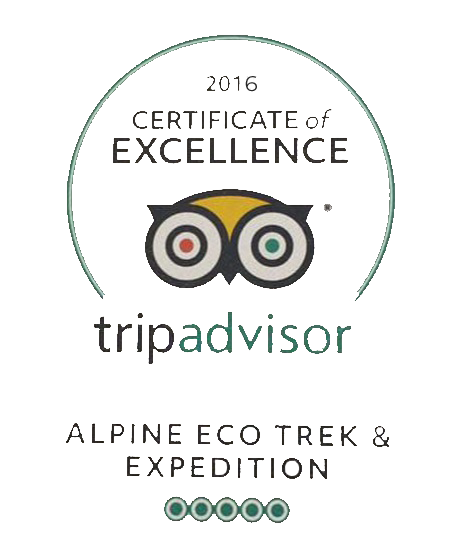
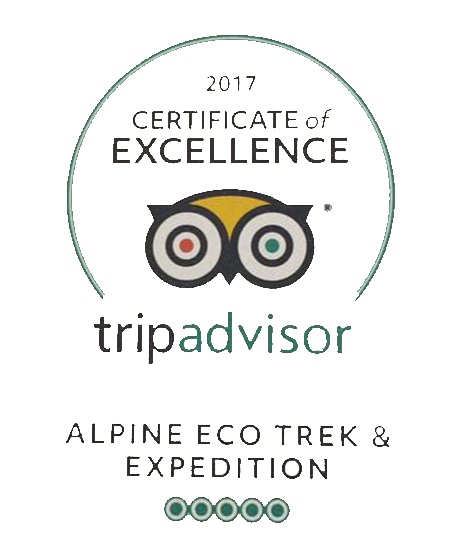
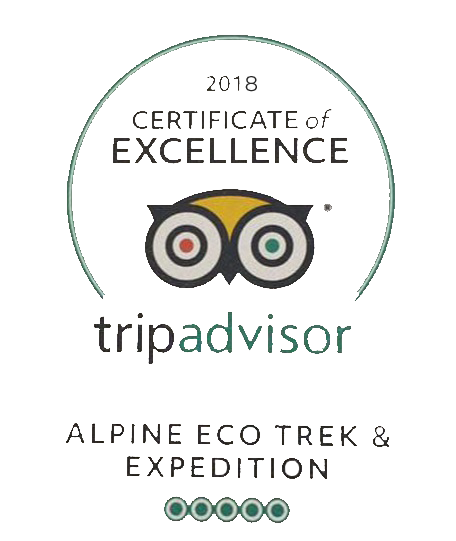
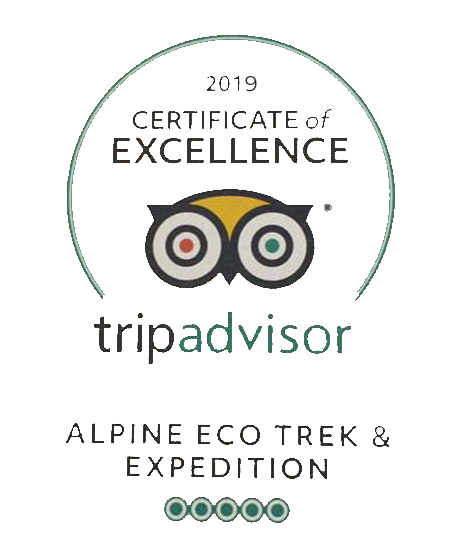


Plan Your Dream Trip with Us
Tell us your interests and travel plans, we'll design the best trip match for you.

Ram Kumar Adhikari
Manager/Owner
Sangita Adhikari
Management Head
Ram Gopal Adhikari
Trip Co-ordinatorNeed a Reference ?
Subscribe to our newsletter
Subscribe to receive the latest adventure travel updates
